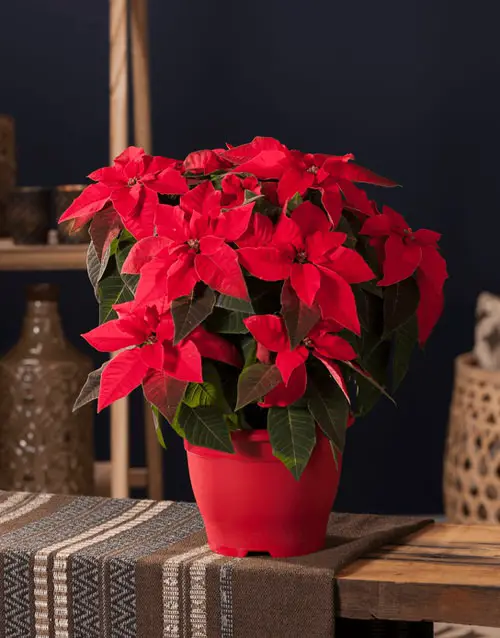Growing Poinsettias from Cuttings can not be tricky if you read this guide till the end and become a propagation expert of this plant!

Planting Poinsettias from Cuttings and keeping them in pots indoors is the best way to add a Christmasy vibe to your home all year round! Let’s have a look at how to do this successfully by learning about the best time, ideal humidity percentage, and steps you need to take for the propagation!
Botanical Name: Euphorbia pulcherrima
Discover the best poinsettia varieties here
A Little Know-How of Poinsettias

Poinsettias are often associated with festive decorations, but you can keep this colorful houseplant in your home garden even after the festivities are over easily and enjoy its vivid hues for months to come.
Best Time to Grow Poinsettias from Cuttings
Warm Zones (USDA Zones 9-11)
Best Season: Fall
- Less Stress on Plants: Autumn offers moderate and cool temperatures in hot climates, reducing stress on cuttings.
- Moderate Climate: Unlike winter, the weather is slightly humid, as well as mildly cool and warm, as well.
- Preparation for Winter: Establishing roots before winter ensures the plant grows nicely in winter.
Cold Zones (USDA Zones 3-8)
Best Season: Late Spring to Summer
- Last Frost Date: Waiting until after the last expected frost date is crucial to avoid freezing the young cuttings.
- Long Daylight Hours: Extended daylight hours promote photosynthesis and growth.
- Warm Soil: Soil temperatures stabilize by late spring, facilitating better root development.
Can You Propagate Poinsettia from Cuttings Almost All Year Round?
Technically, yes, you can attempt to grow Poinsettias from cuttings throughout the year, but success rates vary. It mostly depends on the micro-climate you’re providing.
Of course, you can’t do it during the harsh winters or summer months (if you live in a frost-free region that falls in USDA Zones 10 and 11 or similar ones).
- Climate Control: If you have a controlled environment like a greenhouse, you can propagate poinsettias any time of the year except for winter.
- Indoor Care: With sufficient light, either natural or artificial, and temperature control, indoor propagation is also possible year-round; you can make one of the mini greenhouses suggested here.
16 Stunning Poinsettia Arrangement Ideas
Growing Poinsettias from Cuttings

- Take cuttings from a healthy plant that has new growth. This will ensure a better success rate because the new growth is more viable, has active growing cells, and is less exposed to pests and diseases.
- Use a sharp pair of sanitized shears to make a clean cut and snip off 4-6 inches-long cuttings from the plant, each with at least one node.
- Remove the lower foliage, leaving at least 2-3 leaves on the top.
- Dip the ends of the cutting in honey or any other rooting hormone.
- Now, fill a pot with any light potting or seed mix; make a small hole by jabbing your finger in the growing medium and plant the cutting about 1-2 inches deep in the soil. Pat the soil around to fix your cutting in place.
- The cuttings will root best in the temperature range of 60–85 F (15-30 C).
Note: Wear gloves before starting the process, as the white sap from the stem can be very exasperating, especially if you are allergic to latex. Make sure sap does not get into your eyes.
Maintaining Right Humidity While Growing Poinsettias from Cuttings
Using a spray bottle, mist the cuttings along with the growing medium and cover it with a plastic bag. Remember, the more the humidity, the better it will be, as poinsettias root best in high humidity, above 70 percent.
Best Location for Growing Poinsettias from Cuttings
Keep the pot at a location where it gets bright, indirect light. Avoid keeping it in direct sunlight. An hour of early morning sun exposure will be great. Also, make sure that the pot has enough space around it for good airflow. The cutting will form roots in 4-6 weeks.
Important Points to Follow While Growing Poinsettias from Cuttings

- Avoid exposing the plant to sudden temperature changes. Do not expose the cuttings to direct afternoon sunlight.
- Keep it away from cold drafts of air, like an AC vent. It can affect the rooting process adversely and may also result in the plant’s death.
- Avoid overwatering the plant at all costs.


